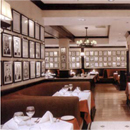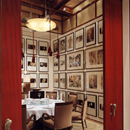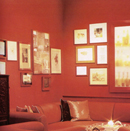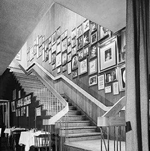
Wunderkammer
Wunderkammer describes an historic exhibition aesthetic in which entire walls or ceilings were covered by a multitude of artifacts arranged by taxonomy. Contemporarily, the term refers to assemblages that cover entire interior planes of related or disparate objects. more
Wunderkammer | Restaurant
application
In the 20th and 21st centuries Wunderkammer installations in restaurants convey chronological histories or thematic concepts.
research
It is important to note that the installation method of Wunderkammer in many of the restaurant environments is different from Wunderkammer in art museums. Originally European and British museums lacked “rational classifications;” instead there was a “bizarre sense of accumulation and juxtaposition” that made the Wunderkammer aesthetic system “so appealing.”1 Wunderkammer in art museums is defined as an assemblage, arrangement and juxtaposition of a diverse collection of objects.2 Contemporary restaurant designs that have been published in trade magazines illustrate objects and images that are not visually chaotic; most confirm to a grid.
Wunderkammer and Theming
Some restaurants in 20th century America became nationally famous, because of their displays of celebrities’ autographed photographs or caricatures. These framed images were arranged variously, but the displays often overlay entire wall surfaces. Among the most well known of the celebrity restaurant types are: Sardi's restaurant, which opened in 1927 in New York City’s theater district, known for the hundreds of caricatures of show-business celebrities that adorn its walls; and the Brown Derby, the Los Angeles restaurant and nightclub that opened in 1926 and was frequented by Hollywood celebrities. The first restaurant in the Brown Derby group was shaped like a derby hat. By 1941, there were three additional restaurants with one at Hollywood and Vine in 1929, Beverly Hills in 1931, and finally Los Feliz in 1941. People flocked to the restaurants to view the caricatures of celebrities that were drawn between 1947 and 1985 by Jack Lane and to eat the Cobb salad that originated with one of the owners.3 The Al and Dick Restaurant (1949) in New York City also featured a Wunderkammer display of photographs of famous people that represented the restaurant’s clientele.4 There may be dozens of examples of this restaurant type across the United States.
After 1950 Wunderkammer displays fade in use by well-known designers until Robert Venturi (Venturi, Scott Brown and Associates) renovated the Tiger Bar and Grill (1992) in the New York City Princeton Club. Venturi’s reiteration of the celebrity restaurant and Winderkammer display included university memorabilia and black and white photographs provided by the university archives. These objects and images of campus activities dominate three walls, providing a chronological history of the school.5
For the Shanghai Lilly (1999) in Las Vegas, Tony Chi installed Wunderakmmer to express the restaurant’s main theme—the high-society courtesan, Shanghai Lilly. This woman and the unique style she established in the 1930s in Shanghai provide the thematic inspiration for this restaurant located in the food court of the Mandalay Bay Resort in Las Vegas.6 The entire restaurant is contrived in homage to Lilly; black and white photographs taken during her entertainment career portray her in all poses and guises. Each photograph is framed with a thin black frame and a large white mat; arranged on a tight grid, the objects cover the walls of the foyer and the private dining rooms.
Wunderkammer in Petterino’s Chicago restaurant (2002) may be the closest reiteration of the 1930 and 1940 celebrity restaurants. In order to fit within the historic surroundings in Chicago’s expanded and renovated Goodman Theatre building, the designer (Design Development Company) and the owner of the restaurant (Richard Melman), worked together to tie the restaurant and the theater together.7 The same sized framed-celebrity-caricatures in Petterino’s dominate every wall and column.
There are a modest number of examples of Wunderkammer internationally. One is the China Club (2004) in Berlin; its walls are covered with large paintings of historically famous Chinese people. Colorful paintings and photographs of Mao Tse-Tung are hung in the entrance and in the dining room. The array of paintings is not as grid-like as Shanghai Lily or Petterino’s, but they create a visual order.
Another reiteration of Wunderkammer is used in the TAO of Vegas bistro, nightclub and lounge (2006) located in the Venetian Hotel and Resort in Las Vegas. The wall surface from floor to ceiling is overlaid with various brightly colored glazed cases display antique opium pipes. Taxonomy is the driving force of the display; each pipe, in multicolored Thai silk, becomes precious in its own vitrine. A grid is the organizing agent for vitrines in the main dining room, tubs filled with water at the entrance tunnel, and numerous monk statues in the bar area. Originally the artifacts for Tao were to be snuff bottles, but instead the more provocative vintage drug paraphernalia were chosen.8
Because Wunderkammer emphasizes composition, it may also facilitate the mixing together of artifacts appropriated from a variety of cultures. The Polynesian theme restaurant was one of the first, and perhaps most successful, of the theme restaurants in mid-20th century America. The Polynesian restaurant depended on Wunderkammer to represent exotic island cultures, borne out by a saturation of effects and furnishings. Such an atmosphere relied heavily on authenticity of design—whether actual or apparent—in effect, stage setting.9
The restaurants of Victor Bergeron (better known as Trader Vic) in San Francisco, Oakland, Beverly Hills, Seattle, and Denver, were described in 1957 as a combination of "Oriental splendor and . . . of Pacific Island primitive designs and Oriental cultural patterns. When he takes on a job, there is nothing pseudo about the results. He goes to the source for original materials and works only with authentic articles."10 In the restaurant these “authentic” materials and goods were combined into a cultural collage, a unified design in which the assemblage of elements became more important than the individual parts. The overall effect depended on mixing, blending and combining to create a composition that removed the objects' hierarchical status, original context or meaning. Objects became ethnographic by virtue of being defined, segmented, detached, and carried away. And it was the accumulation of parts that became recognized as representative of a Polynesian restaurant in the United States. “The material concerns of everyday life intersected with the agencies of display as objects and made exotic. The emphasis on making is important, for display not only shows and speaks, it also does."11 In other words, when objects from a variety of Polynesian cultures were appropriated and mixed together in a Wunderkammer inappropriate appropriation occurred.
A 2006 example of a culturally problematic Wunderkammer is the Tao bistro in which elements of Taoism and Buddhism are combined to suggest that they are the same. Tao refers to a variety of philosophical and religious traditions and concepts; Taoism is not considered by many to be a unified religion. Conversely Buddhism is a family of beliefs and practices considered by many to be a religion. Together Taoism and Buddhism have shaped Chinese life and thought for nearly twenty-five hundred years.
The use of Wunderkammer by designers and architects in American theme restaurants began about 1940 and continues as a viable interior design practice.12 Wunderkammer, developed as a vernacular display, began in the 1930 decade; it is probably the most used technique for any theme restaurant. The T.G.I.Friday’s restaurant chain, founded in 1961 in New York City, includes over 800 restaurants in 50 countries. All use Wunderkammer to exhibit American material culture objects that range from antiques to canoes and airplane propellers. T.G.I.Friday’s Wunderkammer of Americana has been widely reiterated by other chains, casual dining and fast-food and restaurants, such as Uno’s Chicago Grill.
end notes
- 1) James Putnam, Art and Artifact: The Museum as Medium (London, New York: Thames & Hudson, 2001), 8-10.
- 2) Joori Suh, “Theory Briefs: Contemporary Interior Design in Museums and Exhibition Spaces.” (M.A. Thesis, Cornell University, 2004), 117-119; Putnam, Art and Artifact, 8.
- 3) For information about the historic preservation efforts on behalf of the Hollywood Brown Derby restaurant chain, see PreserveLA.com.
- 4) “Stone, Brick, and Wood,” Interiors 8, no. 3 (March 1949): 114.
- 5) Karen Maserjian, “Venturi, Scott Brown,” Interior Design 63, no. 10 (Oct. 1992): 184-187.
- 6) Matteo Vercelloni, New Restaurants in USA 2 (Milano: L’archivolto, 2003), 164-173.
- 7) Kelly Beamon, “Class Act,” Hospitality Design 24, no. 2 (March, 2002): 55-57.
- 8) Debra Scott, “The TAO of Vegas,” Interior Design 77, no. 4 (Apr. 2006), 270.
- 9) Minor L. Bishop, "Atmosphere for Gourmets," Interiors 125 (March 1966): 125-127 in Jan Jennings, “Kon-Tiki, Kahiki and Wan: Landscapes for Dining,” (paper presented at Cornell University Department of Architecture’s Conference, Landscapes: Sublime Popular Ruined Surreal, Ithaca, New York, Sept. 2001). For the design history of Polynesian theme restaurants and specific artifacts and cultures, see Mercer, Jeanne Alaine. “The Polynesian Theme in American Restaurants: A Case Study of Cultural and Design Appropriations,” M.A. Thesis, Cornell University, 1997.
- 10) Edward J. Mayland, "Dine in Tropical Splendor at the Traders," Cooking for Profit 26 (July 1957): 9-11, 18.
- 11) Barbara Kirshenblatt-Gimblett, Destination Culture: Tourism, Museums, and Heritage (Berkeley: University of California Press, 1998), 18, 128. (Emphasis in original).
- 12) Evidence for the use and the chronological sequence of Wunderkammer as a restaurant archetype was developed from the following sources: 1940 Imperial House [1946] Mabel Schamberg; Chicago, IL in "Suggestions of Three kings," Interiors 3, no. 10 (Oct. 1946): 103; PhotoCrd: Hedrich Blessing Studio; Al and Dick Restaurant [1949] Nemeny and Geller, New York City in "Stone, Brick, and Wood," Interiors 8, no. 3 (Mar. 1949), 114; PhotoCrd: Ezra Stoller: Pictorial Services / 1960 The Cousins Club [1968] Norman De Haan Associates; Chicago, IL in "Restaurant by Day Club by Night," Interior Design 39, no. 4 (Apr. 1968): 181; PhotoCrd: Philip A. Turner / 1990 St. Paul Grill [1990] Hammel Green and Abrahamson, Inc., St. Paul, MN in Judi Radice, Restaurant Design 3 (Glen Cove, NY: Architecture & Interior Design Library, 1992), 186; PhotoCrd: Tim Street-Porter; Tiger Bar and Grill at the Princeton Club[1992] Venturi, Scott Brown and Associates, New York City in Karen Maserjian, "Venturi, Scott Brown," Interior Design 63, no. 14 (Oct. 1992), 184; PhotoCrd: Matt Wargo; Shanghai Lilly [1999] Tony Chi & Associates, Las Vegas in Matteo Vercelloni, New Restaurants in USA 2 (Milano: L'archivolto, 2003), 170; PhotoCrd: Paul Warchol / 2000 St. Martins Lane [2000] Philippe Starck and Anda Andrei; London, UK in Melissa Barrett Rhodes, "Room with a Hue," Interior Design 71, no. 1 (Jan. 2000): 131; PhotoCrd: Todd Eberle; Strip House [2001] Rockwell Group; New York City in "Strip House," Interior Design 72, no. 14 (Nov. 2001): 114; PhotoCrd: Paul Warchol; Petterino's Chicago [2002], Design Development Company, Chicago, IL in Kelly Beamon, "Class Act," Hospitality Design 24, no. 2 (Mar., 2002), 56; PhotoCrd: Mark Ballogg; China Club [2004], AMJ Design, Berlin, Germany in Otto Pohl, "Bling Dynasty," Interior Design 75, no. 8 (June 2004), 132; PhotoCrd: Ken Hayden; Buddakan [2006] Christian Liaigre; New York City in Craig Kellogg, "Chow Fun," Interior Design 77, no. 4 (Apr. 2006): 242; PhotoCrd: Eric Laignel; The TAO of Vegas, Venetian Hotel & Resort [2006] Studio Gaia & Thomas Schoos Design; Las Vegas, NV in Debra Scott, "The TAO of Vegas," Interior Design 77, no. 4 (Apr. 2006), 270; PhotoCrd: Warren Jagger; Chinatown Brasserie [2007] William T. Georgis Architect; New York City in Jana Schiowitz, "Imperial Comfort," Hospitality Design 29, no. 2 (Mar. 2007): 110; PhotoCrd: Roberto D'Addona; Auberge [2007] Patrick Jouin; Alsace, France in Ian Phillips, "A Feast for the Eyes," Interior Design 78, no. 9 (July 2007): 211; PhotoCrd: Eric Laignel.
bibliographic citations
1) The Interior Archetypes Research and Teaching Project, Cornell University, www.intypes.cornell.edu (accessed month & date, year).
2) Cho, Jasmin. “Theory Studies: Archetypical Practices of Contemporary Restaurant Design.” M.A. Thesis, Cornell University, 2009, 65-75.





